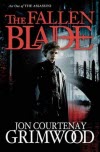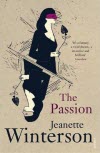Venice: Death and Passion
Sam Jordison goes to Venice in the company of Jon Courtenay Grimwood and Jeanette Winterson.
Not everyone sets foot in Venice, but we all go there in one way or another. It’s one of those cities you can feel you know even before you visit. Images of the place float easily to the mind’s surface. Gondolas, the Doge’s palace, St Mark’s Square, The Bridge of Sighs, red and white poles sticking out of the brown water. You can see them, can’t you?
And that’s why part of the thrill of arriving in Venice is a feeling of recognition. And why actually riding Vaporetto number one down the Grand Canal for the first time is a disconcerting experience. It’s like having a dream coming true. Or perhaps meeting Father Christmas. This astonishing place — this strange place — that seems to have always been somewhere in the depths of our imagination… What is it doing under the real sun?
And of course, the city can also offer plenty you might never expect — and could never experience without being there. The evocative smell of lagoon water and two-stroke engine oil. The wonderful sight of cardboard cartons heaped over with fresh porcini in the autumn rialto market. The happy feeling when a fortunate turn after a bridge leads you to a snug osteria; one whose hot, short, black coffee sends you powering through the throng for the next forty minutes — and longing to return to its quiet, wood-lined sanctuary for the next three hours — if only you could find it again. The brief pleasure and long horror of a cold beer followed by a mind-blowing bill.
Yes, it should also be admitted that visiting is Venice hard work. Even without the crowds of gawping tourists — one of whom is you — there are difficulties. The wine is bad. The food is poisonous. The locals are rude. The hotels are generally dingy and always over-priced. It is, as I was once informed by a couple from Florida, “worse than Disneyland.”
None of that stops me longing to visit again. If I had the time and money I’d go tomorrow. Yet there’s something to be said for staying at home too. If you have a good book to take you there, the Venice of the mind can be every bit as rewarding as the real thing — not to mention easier and cheaper to reach.

I was reminded of this fact anew a few weeks ago when I was lucky enough to get hold of a proof copy of Jon Courtenay Grimwood’s The Fallen Blade [Purchase]. It’s definitely far too early to start dealing in hyperbole about fantasy books of the year, so let’s just say this one is a very good start. It’s a novel you can gorge yourself on; a fast-paced, swashbuckling adventure of the old school, full of fire and brimstone thrills and rich flavours. Yet, unlike many such page-turners, it doesn’t leave a bad aftertaste. Rather, it leaves plenty to ponder. It can be unashamedly lurid. There’s also a rather Hollywood love story that will demand indulgence from more cynical readers. But this isn’t dreck. Even the portrayal of a teenage vampire feels dark and worthwhile (and thankfully removed from the legions of weightless saccharine undead that are currently doing such good business for authors like Stephanie Meyer.) Grimwood has substance as well as style, and that’s exemplified in his portrayal of Venice.
He plunges into the city during the 15th century, when Venice was at the height of her powers, known as Serenissima — the serene Queen of the Adriatic — and a time when its politics were as labyrinthine and dangerous as its hundreds of dark alleys and twisting waterways. The city as Grimwood portrays is easily recognisable as the one we all know so well — yet also entirely different.
“Venice is in the mind,” he told me when I sent him a few questions about his vision of the city. In The Fallen Blade, we can assume that to mean the darker regions of the sub-conscience. A place of disease, piss pots, backstabbing in a variety of literal as well as metaphorical ways. A place of casual violence, violent sex, sexual ambiguity, ambiguous morality, immoral politics… It’s decaying even as the foundations are being laid for that other modern Venice which we know so well, and which has been preserved so long.
One character sees it as: “a bubbling pot into which some celestial threw endless rice. And though each morning began with bodies of beggars against walls, new born infants in back canals, paupers dumped to avoid the inconvenience of burying them — those unwanted, even by the unwanted — the city remained as crowded, and as packed, and as expensive, as he remembered it ever having been.”
Another, Tycho, the aforementioned vampire, takes an even bleaker line. When he finds himself in a half submerged dungeon where prisoners have to constantly work a wheel to stop themselves drowning, we are told he sees “Serenissima. The varied councils, the courts within courts, the Arsenalotti at war with the Nicoletti, the cittadini jealous of the patricians, the patricians divided into old house and new, rich and poor. No one in Venice got off the wheel.”
When I asked him about his own view of the place, meanwhile, Grimwood put it this way:
“There are definitely a number of Venices layered over each other and the murano glass and glitter only hides so much of its darker core. It’s hard not realise the city is constructed from stolen property. The palace and basilica alone are a mass of looted statues, pillars stolen from synagogues and mosques and churches, pillaged artworks. The evidence of the saying Venetians first, Christians second is obvious. This dark heart makes it perfect for fiction.”
It makes for fine reading too. I found it delightful — even if I was glad I wasn’t actually there. Accordingly, I’d recommend the book to anyone. But doing that here seems slightly surplus to requirements. Telling readers of Salon Futura that they might enjoy a Jon Courtenay Grimwood book seems as useful as telling them it’s dark at night. All you need to know is that his latest is up to standard and we can move on.

Really, I want to head for something different, even if it’s also about Venice — The Passion [Purchase], by Jeanette Winterson. Before I get there, however, I feel I should shift some of the rest of that great literary weight that rests on the Serenissima’s watery foundations. No writer describing Venice can ignore the fact that so many have gone before. And it takes a certain amount of guts to follow on from heavies like Byron, Hemingway, Thomas Mann, Evelyn Waugh, Daphne Du Maurier, Goethe, Stendhal, Dante… Or at least, it would if the city weren’t so open to the individual imagination. Venice survives each interpretation… And, just as importantly, the better writers survive Venice. Each makes their own version of it — and they all have an allure of their own. Or, as Jeanette Winterson says:
“Venice is quantum, a Schrödinger’s cat of a city, simultaneously dead and alive, true and false, solid and watery, firm and disappeared.
“Which is why writers love to write about it. Venice offers endless imaginative possibilities, and replays the compliment of a writer’s adoration by giving herself over to language more freely than in any other medium. Pictures and photographs easily become clichés, and film of Venice is always what we have seen already.
Words can hold Venice without fixing her, avoiding the cliché while encouraging the mystery.”
There. I told you she was good. But as that quote may perhaps suggest, she can also sometimes be frustrating and capable of sun-eclipsing pretension. Fortunately, these problems don’t emerge in The Passion, the masterpiece she wrote when she was only 28. Like The Fallen Blade, The Passion takes a definite point in Venetian history (the brief period of Napoleonic rule) – and runs away with it. As Winterson puts it on her website: “It uses history as invented space.”
Her Venice is one in decline:
“A city surrounded by water with watery alleys that do for streets and roads and silted up back ways that only the rats can cross. Miss your way, which is easy to do, and you may find yourself staring at a hundred eyes, guarding a filthy palace of sacks and bones…”
Sometimes, it sounds like the city in The Fallen Blade, especial since Winterson too sees new layers behind the tourist façade:
“The city within the city that is the knowledge of the few. In this inner city are thieves and Jews and children with slant eyes who come from the eastern wastelands without father or mother. They roam in packs like the cats and the rats and they go after the same food. No one knows why they are here or on what sinister vessel they arrived. They seem to die at twelve or thirteen and yet they are always replaced.”
More often, it has a quality all of its own. A place of gambling, decadence and love, where a boatsman’s daughter is born with webbed feet and has her heart stolen by a woman who keeps it in a jar. A place where someone can wear a crown “made out of rats tied in a circle by their tails.” But also one that it is impossible not to love.
I fell for it again when I revisited The Passion after reading The Fallen Blade. This is a Venice of endless possibility and excitement; a place, in fulfilment of the title, of passion. It’s astonishing how much Winterson crams into 160 pages. The story of the boatsman’s daughter and her missing heart seems to take in the whole universe – and plenty more outside it.
On that note, I should also say that the book isn’t just about Venice. Quite a lot of it follows Napoleon’s grand army (mainly through the eyes of the man who serves up the chickens that the little emperor likes to eat whole) from the English channel all the way to Moscow and the Russian winter:
“When our horses died of cold we slit their bellies and slept with our feet inside the guts. One man’s horse froze around him; in the morning when he tried to take his feet out they were stuck, entombed in the brittle entrails. We couldn’t free him, we had to leave him. He wouldn’t stop screaming.”
So, rather less welcoming than Serenissima – and with even worse sleeping accommodation, but in Winterson’s hands, just as fascinating. Location isn’t everything, after all. It’s the writing that counts – and Winterson’s writing is exquisite. But don’t take it from me. Take it from someone who has also made Venice his own, Jon Courtenay Grimwood:
“I’d actually forgotten The Passion when I wrote The Fallen Blade, but I remember buying the paperback when it first came out and loving Winterson’s Venetian heroine with her webbed feet and thinking how devious it was to make the hero Napoleon’s chicken chef. I loved the book, and its shortness and lack of padding make it even more perfect.”